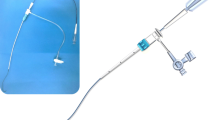Abstract
Purpose
To assess the technical feasibility of transfemoral intra-arterial chemotherapy for head and neck cancer using a 3-French catheter system (3-Fr).
Materials and methods
Sixty-two patients with head and neck cancer who underwent transfemoral intra-arterial chemotherapy were included in this study. Thirty-three patients underwent treatment using a 3-Fr (group 3-Fr). Twenty-nine patients underwent treatment using a 4-French catheter system (group 4-Fr). The technical success rate, duration of the procedure with fluoroscopy, and rate of procedure-related complications were compared between group 3-Fr and group 4-Fr. In addition, in group 3-Fr, bleeding at the puncture site after 1.5 h of bed rest was evaluated.
Results
The technical success rate was 100 % in both groups. The duration of the procedure with fluoroscopy didn’t differ between group 3-Fr (mean 28.0 min) and group 4-Fr (mean 30.2 min) (p = 0.524). There was no procedure-related complication in either group. In group 3-Fr, no hemorrhagic complication was observed.
Conclusion
A 3-French catheter system can be used to perform transfemoral intra-arterial chemotherapy for head and neck cancer and is technically feasible with approximately the same duration of the procedure with fluoroscopy. Furthermore, this method may shorten the bed rest time without hemorrhagic complication, and may reduce the risk of pulmonary embolism.

Similar content being viewed by others
References
Robbins KT, Storniolo AM, Kerber C, Seagren S, Berson A, Howell SB. Rapid superselective high-dose cisplatin infusion for advanced head and neck malignancies. Head Neck. 1992;14:364–71.
Robbins KT, Kumar P, Wong FS, Hartsell WF, Flick P, Palmer R, Weir AB 3rd, Neill HB, Murry T, Ferguson R, Hanchett C, Vieira F, Bush A, Howell SB. Targeted chemoradiation for advanced head and neck cancer: analysis of 213 patients. Head Neck. 2000;22:687–93.
Robbins KT, Kumar P, Regine WF, Wong FS, Weir AB 3rd, Flick P, Kun LE, Palmer R, Murry T, Fontanesi J, Ferguson R, Thomas R, Hartsell W, Paig CU, Salazar G, Norfleet L, Hanchett CB, Harrington V, Niell HB. Efficacy of targeted supradose cisplatin and concomitant radiation therapy for advanced head and neck cancer: the Memphis experience. Int J Radiat Oncol Biol Phys. 1997;38:263–71.
Imai S, Kajihara Y, Munemori O, Kamei T, Mori T, Handa T, Akisada K, Orita Y. Superselective cisplatin (CDDP)-carboplatin (CBDCA) combined infusion for head and neck cancers. Eur J Radiol. 1995;21:94–9.
Gowda S, Bollis AM, Haikal M, Salem BI. Incidence of new focal pulmonary emboli after routine cardiac catheterization comparing the brachial to femoral approach. Cathet Cardiovasc Diagn. 1984;10:157–61.
Yasuno M, Onodera T, Kawata R, Ishida M, Saito Y, Takahashi M. Pulmonary embolism as a complication of transfemoral arteriography: incidence, symptoms, and prevention. Jpn Cric J. 1984;48:439–44.
Kurokawa Y, Abiko S, Okamura T, et al. Pulmonary embolism after routine cerebral angiography: three case reports. Neurol Med Chir (Tokyo). 1995;35:305–9.
Keane JF, Fellows KE, Lang P, et al. Pediatric arterial catheterization using a 3.2-French catheter. Cathet Cardiovasc Diagn. 1982;8:201–8.
Kiyosue H, Okahara M, Nagatomi H, Nakamura T, Tanoue S, Mori H. 3.3-F catheter/sheath system for use in diagnostic neuroangiography. Am J Neuroradiol. 2002;23:711–5.
Tajima T, Yoshimitsu K, Irie H, et al. Percutaneous transfemoral hepatic arterial infusion catheter placement with the use of a downsized coaxial catheter system: technical feasibility study. J Vasc Interv Radiol. 2008;19:1196–201.
Kiyosue H, Okahara M, Nagatomi H, et al. 3.3F catheter/sheath system for use in diagnostic neuroangiography. Am. J Neuroradiol. 2002;23:711–5.
Ohuchi Y, Kaminou T, Hashimoto M, et al. Transfemoral approach using a 3.5-French catheter system for use in transcatheter arterial chemoembolization in patients with hepatocellular carcinoma: technical assessment. Hepatogastroenterology. 2011;58:916–21.
Pollard SD, Munks K, Wales C, et al. Position and mobilisation post-angiography study (PAMPAS): a comparison of 4.5 hours and 2.5 hours bed rest. Heart. 2003;89:447–8.
Kato F, Sato Y, Yuasa N, et al. Reduction of bed rest time after transfemoral noncardiac angiography from 4 hours to 2 hours: a randomized trial and a one-arm study. J Vasc Interv Radiol. 2009;20:587–92.
Steffenino G, Dellavalle A, Ribichini F, et al. Ambulation three hours after elective cardiac catheterisation through the femoral artery. Heart. 1996;75:477–80.
Thoré V, Berder V, Houplon P, et al. Role of manual compression time and bed rest duration on the occurrence of femoral bleeding complications after sheath retrieval following 4Fr left-sided cardiac catheterization. J Interv Cardiol. 2001;14:7–10.
Kiyosue H, Mori H, Matsumoto S, et al. Standardization of use of 4-F size catheter for selective transcatheter angiography and intervention of abdomen. Nippon Igaku Hoshasen Gakkai Zasshi. 1996;56:32–6.
Robbins KT, Kumar P, Harris J, et al. Supradose intra-arterial cisplatin and concurrent radiation therapy for the treatment of stage IV head and neck squamous cell carcinoma is feasible and efficacious in a multi-institutional setting: results of Radiation Therapy Oncology Group Trial 9615. J Clin Oncol. 2005;23:1447–54.
Yokoyama J. Present role and future prospect of superselective intra-arterial infusion chemotherapy for head and neck cancer. Jpn J Cancer Chemother. 2002;29:169–75.
Leffers AM, Wagner A. Neurogenic complications of cerebral angiography: a retrospective study of complication rate and patient risk factors. Acta Radiol. 2000;2000(41):204–10.
Wagenbach A, Saladino A, Daugherty WP, et al. Safety of early ambulation after diagnostic and therapeutic neuroendovascular procedures without use of closure device. Neurosurgery. 2010;66:493–7.
Author information
Authors and Affiliations
Corresponding author
Ethics declarations
Conflict of Interest
The authors declare that they have no conflict of interest.
About this article
Cite this article
Watanabe, S., Yamamoto, A., Torigoe, T. et al. Feasibility and safety of transfemoral intra-arterial chemotherapy for head and neck cancer using a 3-French catheter system: comparison with a 4-French catheter system. Jpn J Radiol 34, 148–153 (2016). https://doi.org/10.1007/s11604-015-0507-1
Received:
Accepted:
Published:
Issue Date:
DOI: https://doi.org/10.1007/s11604-015-0507-1




